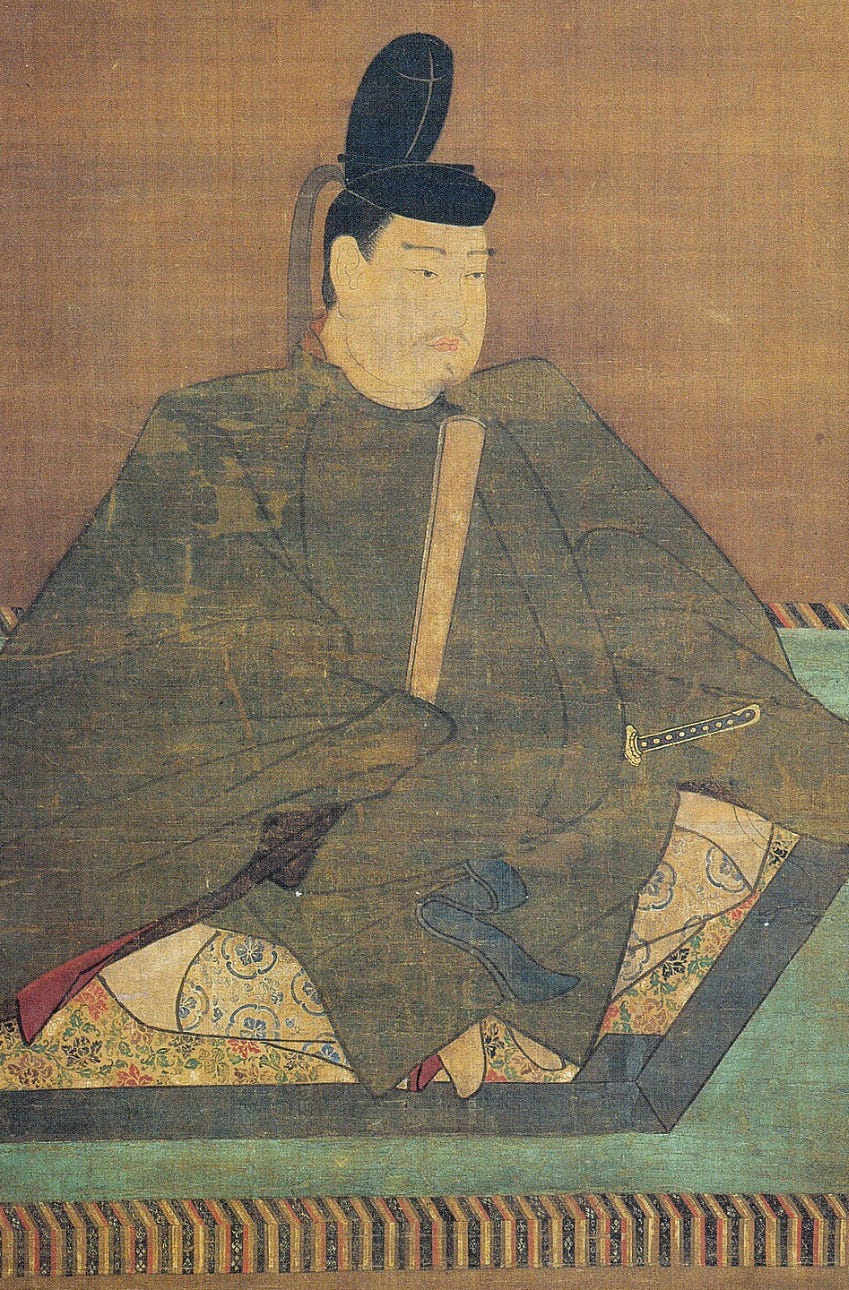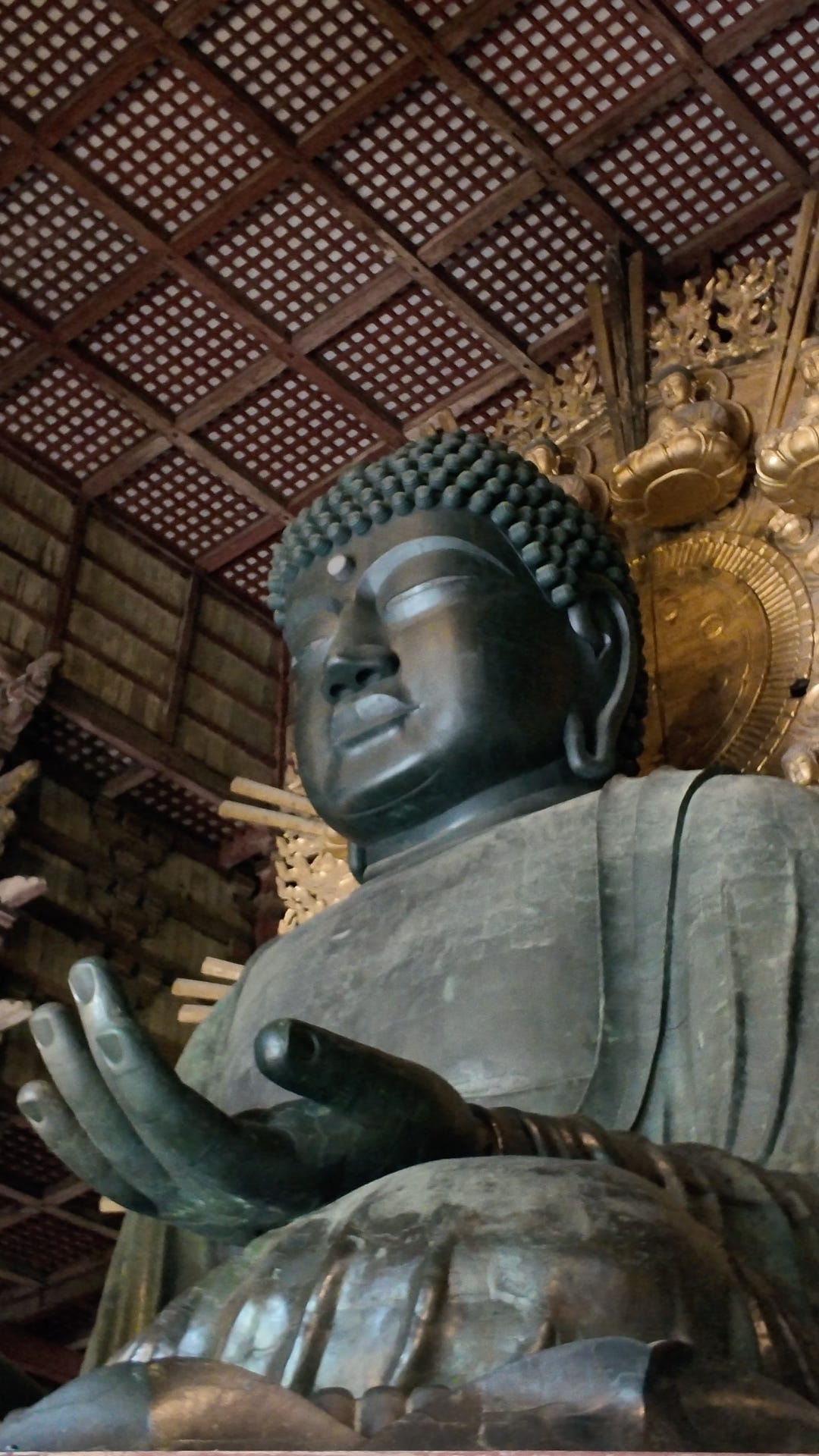Shaken Down by Deer, Inspired by a Buddha
And the First Known Indian to Reach Japan
Last week, working with the BBC in Nara (more on which in the coming months), I spent a few pleasant hours being shaken down by deer for crackers.
Don’t let memories of Bambi fool you. In Japanese culture, these extraordinary creatures are messengers from the gods. It’s hungry work, and they’re not shy. If they want what you’re holding, they’ll nudge, nip, or even head-butt you from behind...
An hour on the train south of Kyoto, Nara has a very special place in Japan’s history. From 710 to 784, it served as the country’s first permanent capital.
Before then, capitals were temporary: encampments for emperors and aristocracy, whose timber buildings could be taken down, carted off and put up elsewhere when needed: when a new emperor ascended the throne, or if rebellion or disease left the old capital feeling cursed.
Nara was designed to be different. Modelled on the great Chinese city of Chang’an, it was laid out on a grid pattern and its buildings had stone foundations: a sure sign that this place would be home for the long-haul.
These were important years for Japan’s imperial family: alongside their new capital, they oversaw the writing of two official histories that placed them front and centre. Bursting with poetry and colourful mythology, these histories - Nihon Shoki (Chronicles of Japan) and Kojiki (Record of Ancient Matters) - included the claim that Japan’s emperors were descended from the gods.
All was not well for long, however. In the 730s and 740s, Emperor Shōmu suffered the loss of his baby son, political factionalism and attempted rebellion. A devastating smallpox epidemic wiped out roughly a third of Japan’s population. Between a million and 1.5 million people died.
Emperor Shōmu, who reigned between 724 and 749
In search of solace and solutions, Shōmu turned to Buddhism - and to one Buddhist in particular.
Bodhisena - known in Japan as Bodai Sōjō - was born in the great South Indian city of Madurai in 704. He was ordained as a Buddhist monk and later travelled to South-East Asia and China. In 736, he made it across to Japan - becoming the first person from India known to have visited the country.
Buddhism had been around in Japan for a couple of centuries by this point, gradually overcoming worries about the country’s native gods (kami) disapproving of an influx of immigrant deities.
Now and again, when a natural disaster struck, someone might try to appease the kami by burning a Buddhist statue or throwing it into a canal. On at least one occasion, Buddhist nuns were stripped and flogged.
But Buddhism clung on, and the tragedies suffered by Emperor Shōmu in the early 8th century helped it grow. He ordered the creation of a nationwide network of Buddhist temples and nunneries, whose monks and nuns would serve as state employees: praying and reciting sutras for the protection of the realm.
The beating heart of this new network was Tōdai-ji in Nara. Originally built as a memorial for Shōmu’s infant son, it became the country’s greatest temple: a centre for Buddhist study - almost a national university - and home to the largest bronze statue the world had so far seen.
The Daibutsu - Great Buddha - was cast in sections, with work carried out all around Japan. Hundreds of tons of copper were used for the bronze alloy, nearly bankrupting the country. Around half of the population is thought to have contributed in some way: money, labour, materials.
When it was finished, the Great Buddha stood nearly 15 metres tall. Its surface was painted - as one of the temple officials told me last week - by dipping brushes into molten gold.
Tōdai-ji’s Great Buddha Hall.
Who was this very special buddha?
In the West, we often imagine that Buddhism’s most revered figure must be the historical Buddha, Siddhartha Gautama, who lived and died sometime around the 6th or 5th century BCE. That isn’t the case.
In the Mahayana Buddhist tradition, Siddhartha is just one of countless buddhas and bodhisattavas. For many, the most important is Vairocana: the cosmic Buddha, source and pattern of everything in existence.
It’s a fascinating - and consoling - way of experiencing the world. The birdsong outside the temple is Vairocana’s voice, guiding and teaching. The deer wandering around in search of tourists with crackers, nudging and nipping as they go: these too are Vairocana.
The Great Buddha at Tōdai-ji is a representation of this cosmic Buddha - but not just a representation. It is him. He is present in it.
This is where Bodhisena comes in. Welcomed by Emperor Shōmu, he lived for a while in Nara, teaching about Vairocana and making friends with some of Japan’s best-known Buddhists.
Prime among them was a monk named Gyōki. Legend has it that when Bodhisena and Gyōki met, they recognised one another from a past life. They had been together at no less a place than Vulture Peak, where they heard Siddhartha Gautama preach the Lotus Sutra: his great teaching reassuring people that the Buddha is everywhere and that all beings can attain salvation.
Statue of Bodhisena, at Ryōsen-ji Temple in Nara
When the Great Buddha was finished, in 752, a grand ceremony was held to bring it ritually to life. Vairocana was invited to take up residence there, so that people could worship him and receive his blessings.
10,000 monks are said to have attended the ceremony. There was music and dancing, from China and Korea.
Then came the big moment. Bodhisena, presumably standing on a high platform erected for the purpose, took up a brush and painted the eyes onto the statue.
Now it was Vairocana.
The colossal ‘Great Buddha’ at Nara. His head alone is five metres tall.
Many parts of the Great Buddha have been replaced over time, after being lost to earthquakes, war and the weather. Vairocana’s gold coating is long-gone. But it’s still easy to imagine the awe that people must have felt upon encountering him. Glittering in the sun, he must really have been the ‘shining, luminous, radiant one’ that his Sanskrit name suggests.
Back out in the park, I found myself dodging the deer once again - they could clearly scent cracker crumbs in my pockets. But the idea stayed with me, and has done since, that Vairocana is everywhere and speaks through everything. It makes the world around seem much more vivid - more meaningful. You don’t have to be a Buddhist, I think, to sense that something here is true and worthy of attention.
—
Images & video
Naughty deer, Tōdai-ji and the Great Buddha: filmed on location at Nara Deer Park, earlier this month.
Emperor Shōmu: Wikimedia (public domain).
Bodhisena: All India Roundup (fair use).






Really interesting article, thanks. I love Nara, the last time I went was during the pandemic when the borders were closed, the deer were absolutely terrifying because there were so few tourists around to feed them!